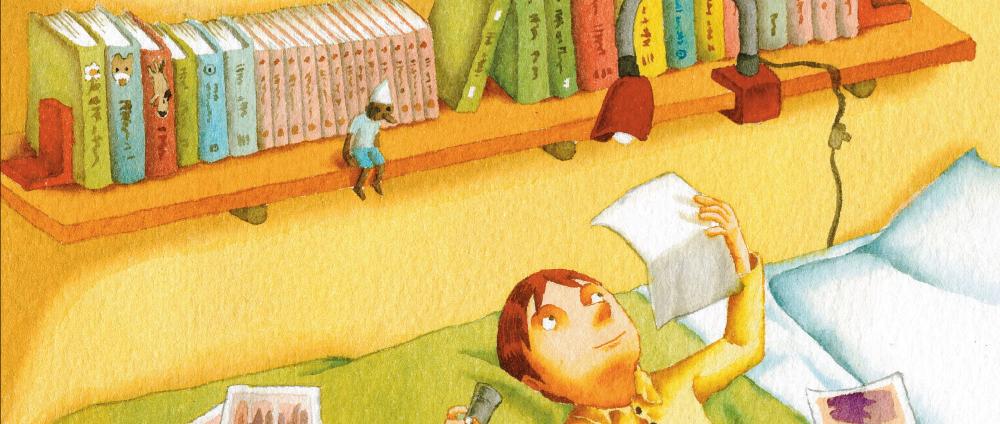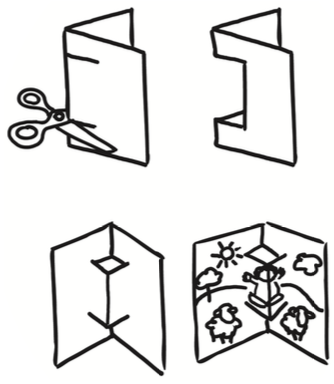
The Lost Son
- Identify with the lost son and imagine his joy at being welcomed home
- Tell what the parable teaches about God.
- Show and express the Father's love.
- Worship God, our heavenly Father.
Session Outline
Leader Reflection
This is one of the most widely known and beloved of Jesus' parables, and it's easy to see why. It has everything a good story needs---emotion, drama, character, and the elusive element of surprise. All that makes it an exciting---but also difficult---story to tell and talk about. Part of the difficulty comes from its very familiarity and part from its complexity---three important and engrossing characters all claim our attention.
It's important to note that this story is part of a series of parables about lostness, all in response to the religious leaders' grumbling that Jesus hangs around with "sinners and eats with them." In each parable Jesus raises the ante of tension, until it nearly explodes in this one. All the participants in the real-life drama have their counterparts in the characters in the parable---the sinners (the lost son), the Pharisees (the older son), and the Son of God (the father). But at the center of this complex story is the father; this isn't at its core the parable of the lost son but of the incredibly loving father.
Let's start with the lost son. It's easy to understate how outrageous his behavior really is. Who would ever think of asking for a share of an inheritance before the parent had died? This is like saying to the father, "I wish you were dead, but since you aren't yet, give me my share now---I'm out of here." The son is thoughtless, ungrateful, and self-absorbed.
His behavior after he leaves only confirms what a scoundrel he is. Throwing his money away in pleasure-seeking, he ends up just where he deserves to be: among the pigs (unclean and despised animals to Jews). Even his "repentance" seems to fall short. We suspect that it may be motivated more by hunger and desperation than by sorrow for what he has done to his father.
Then there's the father. As outrageous as the lost son's actions are, the father's seem even more unwarranted. He's continually gazing down the path, pining for the scoundrel's return. And, when he finally glimpses the kid, he does something terribly undignified. In that culture, no man of substance would run, and yet the father hitches up his long robe and scuttles on his old, gangly legs to embrace his son, in full view of the scandalized neighbors.
And it doesn't stop there. Before the kid can blurt out his well-rehearsed speech, the father covers his face with kisses, calls for a robe and a ring, and orders a party in the son's honor. Ridiculous! Let the kid know much grief he's caused, we want to object, or at least let him work his way back into favor. Instead, the father's love is so immediate, so extravagant, that we shake our heads in bewilderment when we hear the story.
Then there's the older brother, who is in many ways the point of the story. We get him. He's the only character who acts like an ordinary person. Of course he's hurt and angry. His stupid kid brother gets all the attention, while he's been right there, plugging away all along and all alone, working hard at being a good son.
Notice that the story ends with no resolution. The father pleads with the older son to join the party and celebrate the return of his lost brother. How will he respond?
What would be going through your mind if you were one of the religious leaders listening to this story?
Do you think the younger son was truly repentant? Does it ultimately make a difference either way?
What other ways might the father have acted, while still accepting back his son?
What do you think the older son will do?
Be sensitive to the family situations of the children in your group. Some may be dealing with very difficult home dynamics, including such issues as divorce, abuse, teenage rebellion, or sibling rivalry. It may be difficult for a child who has never experienced a positive example of an earthly father to envision a loving heavenly Father. Even in this situation, the story has healing power. This is what God is like, and God is the ultimate model for earthly parenthood, not the other way around.
Explore the outrageous behavior of all the characters, even as you notice together that the most ordinary and expected behavior comes from the older brother.
Try to fit the parable into its biblical context of the Pharisees’ questions, and show how each character is intended to answer them.
Ultimately focus on the father, who stands at the center of the story—and on the loving God he represents.
Steps
None needed
Warmly greet students as they enter the room. Briefly touch base with each child (both those who attended last time and any who are new). You may want to invite the kids to tell you something funny or exciting or special that happened to them during the week. Give positive feedback to those who’ve remembered to bring their Bibles with them today.
Invite the group to think about ways in which they’ve seen God in their lives during the past week. Maybe it’s just in day-to-day things—like having enough to eat. Maybe something more extraordinary happened this week (safety during an accident or near-accident or healing from a bout with strep throat, for example). Be prepared to mention a few of the ways in which you’ve seen God at work in your own life too—and in the beauty of the world around you.
Hand out pencils and one or two note cards to each person. Ask kids to close their eyes and take a deep breath, and then to write down one or two words that describe who God is or what God is like (for example, a loving Father or a mighty protector). Tell kids that you will be using their own descriptive words—often called attributes—in an opening prayer. (You may wish to play music from the Dwell CD—especially the song “Amazing Grace (My Chains Are Gone)”—as group members think and write. After two minutes or so, collect the cards.
Begin your time of prayer by saying “God, we thank you for being . . .” Then read the attributes on each card. (Or cue group members to read their own cards.) During the prayer encourage everyone to reflect quietly on God’s goodness.
Conclude your prayer time by inviting the group to say the sign language prayer from Session 1, “Speak, Lord, your people are listening,” as they prepare to hear God’s story.
The Reformed way of looking at the Bible involves understanding that God is always the main character in the overarching story. Seen in that light, this story is ultimately about the love and forgiveness of the father—not about sibling rivalry or teenage rebellion.
Story symbol from previous session
Notebooks
Display or draw the symbol for today’s story. Ask the group to guess what the story might be about. Explain that Jesus told today’s story to the same group of people he told last week’s story to: Pharisees, tax collectors, and sinners. Invite them to tell you what they remember about that audience, especially the Pharisees. (Note the invitation on today’s Storymark to find out more about the Pharisees.)
Ask children to open their Bibles to Luke 15:11-32, commenting that this story, the story of a father and two sons, is another part of God’s big story. Choose a few volunteers to read the story out loud. If your group wrote in their notebooks during the last session, hand out the mini notebooks and pencils again (or invite group members to get them from their “mailboxes”). As they listen to the story, invite them to write down words that describe how each character might have felt, or to draw a picture that helps them visualize the story.
Story symbol, session 2 printable page
Spontaneous Drama printable pages
Character Nametags printable page
Next invite the group to retell the story by performing it as a spontaneous melodrama. A melodrama is a type of skit that uses exaggerated acting to emphasize the action and emotion of the story. Since this story is loaded with emotions, both sad and joyful, and action all the way from feeding pigs to celebrating at a feast, it should be easy to dramatize. Use your copy of the story script (printable pages) and assign everyone a part in the script by passing out character tags (printable page) along with a piece of tape. Choose outgoing kids who enjoy being the center of attention to take the three main roles.
- Father
- Older Son
- Younger Son
- Servants (optional)
- Friends (optional)
- Farmer (optional)
- Pigs (optional)
Make sure everyone has a role (you can include as many servants, friends, and pigs as needed!).
Choose a space in your room (or move to a larger room) so that everyone can stand and move around for the skit. You may want to hang signs to identify where the father’s house and the distant country are in your room. Tell the children to listen for their cues and to act out the story as it’s being read. Let them know that when their character has a line, they’ll need to repeat after you with intense emotion and expression. Encourage the younger son and his friends to really get into their wild living, the father to welcome his son back dramatically, and the pigs to snort a lot. The kids will get into it quite quickly! The key word is “exaggerate!”
You may want to practice by reading a few lines and coaching your actors a bit. When everyone understands their role, read the story from the script slowly (but enthusiastically), emphasizing each character or animal’s name. Some small prompts from you may still be necessary as the story moves along. Have fun as you narrate the story! The group will follow your enthusiastic lead.
When you’re finished acting out the story, talk about it together with some or all of the following questions:
- What do you suppose the younger son thought would happen when he got to his father’s house? What ideas ran through his mind as he took those last steps?
- Can you think of a time when you were forgiven for something very wrong or hurtful you had done? How did it feel?
- The groups listening to the story were Pharisees, tax collectors, and sinners. How do you imagine each group of people reacted to this story? Why? What do you imagine members of each of these groups said to Jesus?
- Where do you see yourself in the story? Are you a younger son? An older son? Why?
- What does this story show you about God?
You may want to use this opportunity to tell your group how much it means to you personally to know that God forgives you—even when you really mess up!
Storymark 2
Song: “My Shepherd Is Near”
Remind the group that the stories Jesus told weren’t just for the people in his day. They’re for you and me too. Pass out the Storymark and invite group members to spend a few minutes filling out the sentence starter on the front of their Storymark:
This story makes me feel . . .
I think Jesus wants me to know that . . .
Invite them to write a prayer to God in their notebooks or in the “My Prayer” section of their Storymark, using these prayer starters:
Dear Father, thank you for being my loving Father, even when . . .
Help me to show your love to others, even when . . .
Amen.
Encourage the children to use their Storymarks to mark today’s passage Luke 15:11-32 in their Bibles. Challenge them to do some of the activities on their Storymark throughout the week and to look for today’s symbol in the God’s Big Story cards. Assure them that you will be doing the same.
Close the session by reading Psalm 23 together or by playing “My Shepherd Is Near” from the CD. Encourage the group to learn verses 1 and 2 of the psalm by next week.
Easy Extras
note cards
pencils
small ball or beanbag
Option for Step 1: Gathering for God’s Story.
Hand out the note cards and pencils and ask each student to write down one word that describes who God is (holy, powerful, compassionate, and so on). Collect the cards, shuffle, and redistribute them. Then have group members read their new cards and remember the word they have been given.
Gather the group in a circle and toss a beanbag or ball to one person. Have that person start the game by saying “God is . . . ” and then tossing the ball to another person in the circle. That person will say the word on the card they were given, and then toss the ball to another person, who will in turn share the word they were assigned. Continue playing until everyone has had a chance to share their word. Then try the game again, this time a little faster! End with a prayer thanking God for having all the characteristics everyone has mentioned. Tell the kids that today’s story will remind them that God is a loving Father.
construction paper
magazines
scissors
glue
markers
Option for Step 3: Living into the Story.
Hand out the materials listed above and ask group members to create a pop-up scene of a part of the story that was especially meaningful to them. Feel free to make suggestions: perhaps the moment when the lost son “came to his senses” while feeding the pigs or the party the father threw for his son. If you have magazines available, group members could cut out pictures to help make their scenes come alive. Invite them to use contemporary scenes and characters, as this story could just as well have taken place in our own day.
Before they begin, demonstrate how to create a pop-up scene, as follows:
- Fold the sheet of construction paper in half, as though making a card.
- Cut two slits on the folded part of the paper.
- Pull the slits forward so that the scene pops out.
- Create as many slits as needed, depending on how many images you want to have pop out from your scenes.
- Either draw images on your pop-outs or cut them from magazines and glue them to the scene.
Give group members time to work on their scenes. Leave the last few minutes for volunteers to share their scenes and explain why the part of the story they chose was meaningful for them. If you have time, challenge the group to put all of the scenes they’ve created in sequential order to retell the story.
“Amazing Grace (My Chains Are Gone)” lyrics
Dwell CD
notebooks
Play this moving version of “Amazing Grace.” Invite group members to draw or write in their notebooks some of their reactions to the words of the song. Ask them to comment on how this song fits with the story Jesus told about the father and the two sons.
Posterboard or construction paper
Dwell CD
Option for Step 4: Living Out of the Story.
Psalm 23 is chock-full of vibrant and colorful word pictures. Challenge your group to create visual images of Psalm 23:1-2 to help them memorize this beautiful psalm. Suggest the following word pictures they might want to use: shepherd, green pastures, and quiet waters. Form small groups to create a poster or mural for the psalm, or have kids work individually on separate sheets of paper.
Encourage the kids to write out the verses at the bottom of the pages, mural paper, or posterboard. If you choose either of the cooperative options (mural or poster), have the same groups work on a different verse each week (instructions included for each additional session of this unit). By the end of the unit, your group will have a colorful display of Psalm 23. As they work, play “My Shepherd Is Near” rap from the CD.

